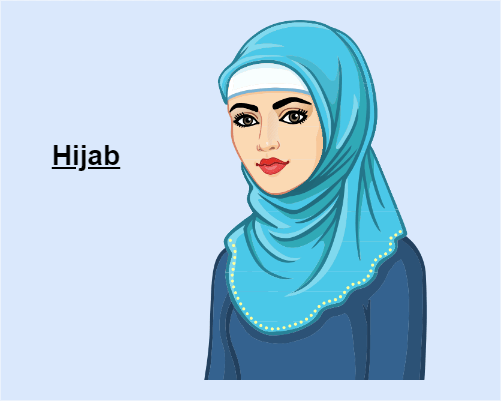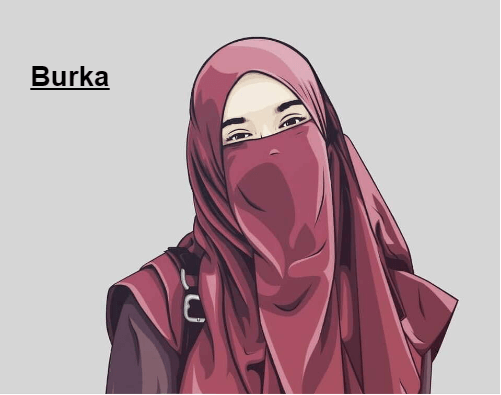Difference between Hijab and BurkaMuslim traditions have been a part of Indian culture since Islam came to India in the 7th century. Later in the 12th century, after the victory of the Guridh and Gaznavids, they had set their roots in Punjab and North India. There are many principles to follow in the Islamic tradition, including determined attires for men and women. According to the Quran, women need to cover their heads and other body parts when in the presence of men as a representation of modesty. The Sunni Islam culture expresses that women should cover their body head to toe except for their hands and eyes. However, the extremities, such as wearing a burka and hijab, are not mentioned in texts. In this article, we explore the significant differences between the hijab and burka to understand the importance of both in their context. Introduction to Hijab
Hijab is a piece of clothing that is wrapped around an Islamic women's neck and head, veiling their hair, neck, and ears but leaving the face uncovered. Since the 1970s, Muslim women have preferred the hijab over the burka as it is illustrated as a symbol of faith and modesty. Typically, girls start wearing the hijab at the age of 7 and often the burqa at the age of 15. In some countries such as Afghanistan and Iran, it is compulsory to wear hijab by women of any religion. In 2022, the court in Karnataka banned women from wearing hijabsin schools and colleges, stating that it is not a mandatory part of the Islamic religion. At the same instance, Prime Minister Narendra Modi had sanctioned Hindu-first policies, resulting in student protests. Apart from this, women are also protesting for not wearing hijab forcefully. Introduction to Burka
On the other hand, the burka(also written as burqa) is the long clothing that covers the head, face, and whole body of a woman. It is worn by women in Islamic countries. The burka (or chadari as referred to by Afghans) was first used in Afghanistan. It was first brought in from Persia and then from India in the 20th century. The Muslim culture expresses that the wives of prophets should wear a niqab so they can avoid gossip and slander. The niqab generally exists in two forms: half niqab and full niqab. The fabric of normal length, which includes elastic or straps and is put on around the face, is known as a half niqab. It leaves out some parts of the forehead and eyes uncovered. The full niqab, or gulf-style niqab, covers the whole face. The burka expresses the modesty and righteousness of a woman and the shunning of Western culture, political aspects, and cultural norms. History of Hijab and BurkaThe term hijab rose from its mention in Quran several times, although it did not have a similar meaning as the burqa. In contemporary Muslim culture, the hijab literally interprets as a curtain. In Quran, the two words that have a similar meaning as purdah are Khimar(24:31) and Jilbab(33:59). However, these words again have different implications from the current ones. Both of these words from the Quran translate to 'chaader'or 'dupatta', which is used to cover the body of a woman but not her face. Thus, the Quranic culture is not the root of the words such as burqa or hijab but the Muslim culture. Burka is known to be a fragment of Muslim culture rather than Islamic or Quranic convention. In the early 7th century, the term burka came into existence in Arabia. At first, the burka was known to be a cloth that was used for protection from the winter season. As described in Lisan-Al Arab, the term burka had two meanings during the pre-Islam period. Initially, it meant the sheeting of animals during the wintertime. Another interpretation of it was the shawl-like cover draped around the body of women during winter. The Quran 'burqa' did not particularly mean 'purdah for women' even though the word exists in Arabic vocabulary. During 633-54 AD, the Muslim conquest in Persia was on the high rise, leading to the decline of the Zoroastrian religion in Persia. There were many traditions introduced by the Persian civilization. Many transformations were made in the Islamic traditions, such as the worship of Khuda instead of Allah and using the word 'Namaz' rather than 'Salat'. Simultaneously, the burka was embraced by Muslims as a part of Iranian heritage. Hence it led to the Islamization of the burka and was adopted into Muslim culture. Different Forms of Headscarves and Veils for WomenThe word hijab does not particularly translate into a headscarf. It is an Arabic word that interprets it as curtain or partition. It is the commonly used term representing modesty for both men and women. There are other religions in which the headscarves are put on by the women, such as Judeo-Christian faiths. In the Jewish culture, women cover their heads as a sign of modesty. Before the 18th century, European Christian women had to cover their heads. Women from Africa and the Mediterranean also used to wear head scarves. However, head scarves are mostly associated with Muslim women. Some of these headscarves and veils are mentioned below: HijabThis cloth leaves the face uncovered but is wrapped around the neck and head. It is available in different forms and colors. It is generally adorned by Muslim women. BurkaA burka and a niqab are quite different from one another, even though they look similar. Burka is a veil that covers the whole body, including the eyes of a woman. The eyes of a woman are blocked by the lattice attached to the burka for women to see. This is mainly worn in countries such as Iran, Afghanistan, and Pakistan. In Israel, some Jewish women tend to cover their heads by wearing this garment. Due to safety protocols, approximately 15 countries have banned women from wearing a burka. NiqabThis piece of clothing covers the hair, neck, and whole face except the eyes. It is commonly sported by women in Arab countries. Muslim women in a multi-religious country such as India also wear the niqab. ChadorChador is a garment that covers the whole body of a woman. However, it is not attached to any pin or hook, and women have to secure it by hand. Iranian women generally wear it. Al-amiraAl-amira is a kind of hijab. It is a two-piece veil worn commonly by women in Southeast Asia. Muslim women wear it to glorify the values of modesty and partition. It is comprised of a tightly fitted cap commonly made of polyester or cotton, and it is joined to a tubular scarf. Difference between Hijab and BurkaLet us now find out the key differences between hijab and burqa with the help of the following table, which will help us to differentiate between the two quickly:
Next TopicDifference between
|
 For Videos Join Our Youtube Channel: Join Now
For Videos Join Our Youtube Channel: Join Now
Feedback
- Send your Feedback to [email protected]
Help Others, Please Share










